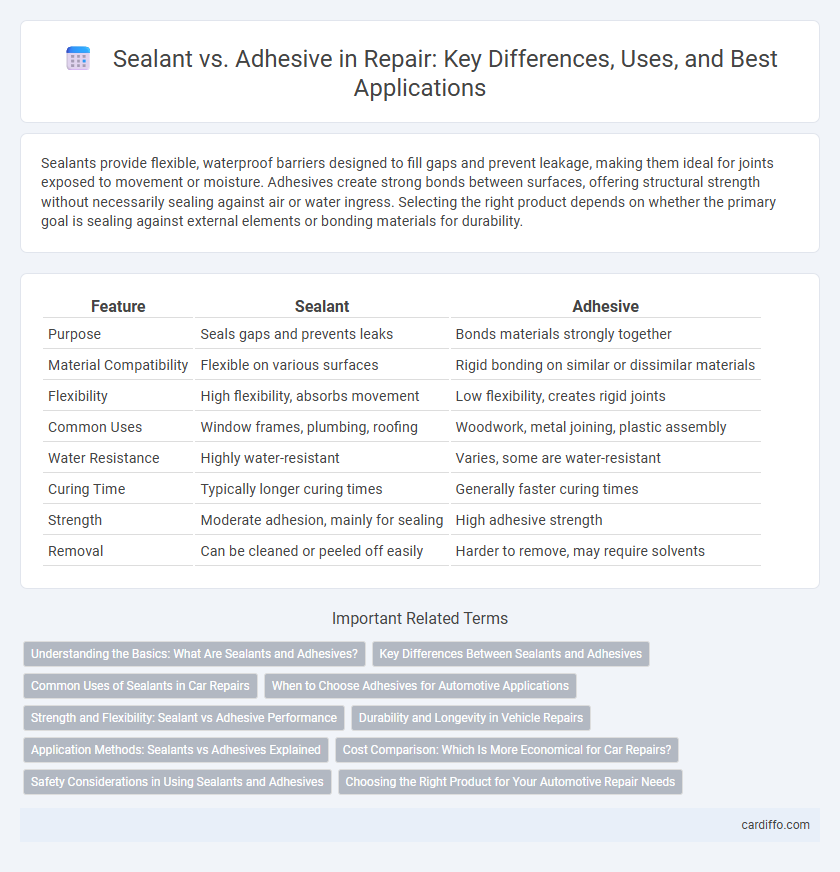Sealants provide flexible, waterproof barriers designed to fill gaps and prevent leakage, making them ideal for joints exposed to movement or moisture. Adhesives create strong bonds between surfaces, offering structural strength without necessarily sealing against air or water ingress. Selecting the right product depends on whether the primary goal is sealing against external elements or bonding materials for durability.
Table of Comparison
| Feature | Sealant | Adhesive |
|---|---|---|
| Purpose | Seals gaps and prevents leaks | Bonds materials strongly together |
| Material Compatibility | Flexible on various surfaces | Rigid bonding on similar or dissimilar materials |
| Flexibility | High flexibility, absorbs movement | Low flexibility, creates rigid joints |
| Common Uses | Window frames, plumbing, roofing | Woodwork, metal joining, plastic assembly |
| Water Resistance | Highly water-resistant | Varies, some are water-resistant |
| Curing Time | Typically longer curing times | Generally faster curing times |
| Strength | Moderate adhesion, mainly for sealing | High adhesive strength |
| Removal | Can be cleaned or peeled off easily | Harder to remove, may require solvents |
Understanding the Basics: What Are Sealants and Adhesives?
Sealants are flexible materials designed to block the passage of air, water, dust, or other substances between surfaces, providing a waterproof or airtight barrier in construction and repair projects. Adhesives are substances formulated to bond two surfaces together through mechanical or chemical means, offering structural strength and durability in various applications. Understanding the differences in composition, curing processes, and intended uses is essential for selecting the right product in repair tasks.
Key Differences Between Sealants and Adhesives
Sealants primarily prevent the passage of fluids, air, and contaminants by filling gaps and joints, whereas adhesives are designed to bond surfaces together with high strength. Sealants remain flexible after curing to accommodate movement, while adhesives often cure to form a rigid or semi-rigid bond. Key differences include their chemical composition, flexibility, curing mechanisms, and primary applications in construction and repair tasks.
Common Uses of Sealants in Car Repairs
Sealants in car repairs are primarily used to prevent water, dust, and air leaks by creating flexible, long-lasting barriers around windows, windshields, and door panels. They are essential for sealing joints and seams to protect against rust and corrosion while ensuring soundproofing and structural integrity. Unlike adhesives, which bond parts together, sealants focus on filling gaps and providing a watertight, airtight seal.
When to Choose Adhesives for Automotive Applications
Adhesives should be chosen for automotive applications when strong bonding between dissimilar materials such as metal, glass, and plastic is required to ensure structural integrity and prevent component separation under stress. They provide superior load distribution and resistance to vibration, making them ideal for assembling body panels, bonding trim parts, and securing interior components. Selecting adhesives with high temperature resistance and flexibility enhances durability in harsh automotive environments.
Strength and Flexibility: Sealant vs Adhesive Performance
Sealants provide superior flexibility, allowing joints to absorb movement and vibrations without cracking, making them ideal for dynamic applications. Adhesives offer higher strength and durability for bonding surfaces permanently, excelling in structural repairs where load-bearing capacity is critical. Choosing between sealant vs adhesive depends on the need for elasticity versus tensile strength in the repair environment.
Durability and Longevity in Vehicle Repairs
Sealants offer superior flexibility and resistance to environmental factors, providing long-lasting protection against moisture and corrosion in vehicle repairs. Adhesives deliver stronger bonding strength essential for structural integrity but may degrade faster under extreme conditions compared to high-quality sealants. Choosing a sealant or adhesive depends on the repair area, with sealants favored for joints and seams requiring durability against weather exposure, while adhesives suit bonding parts demanding high shear strength.
Application Methods: Sealants vs Adhesives Explained
Sealants are typically applied with a caulking gun or putty knife to fill gaps and create a flexible, waterproof barrier, while adhesives require precise bonding techniques such as spreading, clamping, or curing to ensure strong, permanent connections. Sealants accommodate movement and expansion between surfaces, making them ideal for joints and seams, whereas adhesives provide structural strength to join materials like wood, metal, or plastic. Understanding these distinct application methods is crucial for selecting the right product to optimize durability and effectiveness in repair projects.
Cost Comparison: Which Is More Economical for Car Repairs?
Sealants generally offer a more cost-effective solution for car repairs due to their lower price per unit and ease of application, reducing labor expenses. Adhesives, while often stronger and more durable, tend to be more expensive and may require specialized tools or professional installation. For budget-conscious repairs, sealants provide an economical option without sacrificing functionality in non-structural applications.
Safety Considerations in Using Sealants and Adhesives
Sealants and adhesives require careful handling due to their chemical formulations, which can emit volatile organic compounds (VOCs) that pose respiratory hazards; using them in well-ventilated areas minimizes exposure risks. Personal protective equipment such as gloves and goggles should be worn to prevent skin irritation and eye injury from direct contact. Proper storage, avoiding open flames, and following manufacturer safety data sheets ensure safe usage and reduce potential fire and health hazards during repair tasks.
Choosing the Right Product for Your Automotive Repair Needs
Choosing the right sealant or adhesive for automotive repair depends on the specific application and material compatibility. Sealants excel in creating watertight and flexible joints, ideal for sealing gaps and preventing leaks around windshields or engine parts. Adhesives provide strong bonding between surfaces like metal, plastic, and rubber, crucial for structural repairs and component assembly in vehicles.
Sealant vs Adhesive Infographic

 cardiffo.com
cardiffo.com